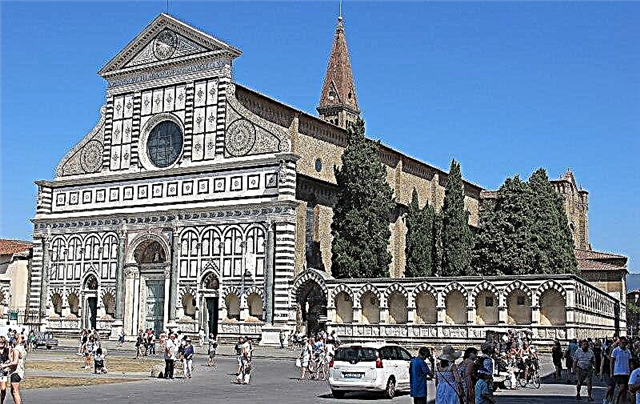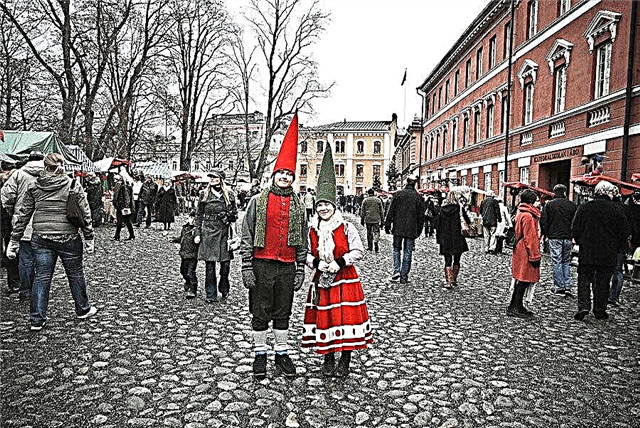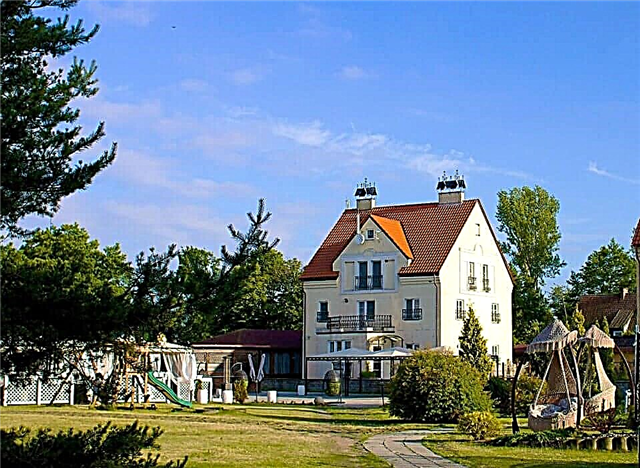The Curonian Spit is located between the Russian city of Zelenogradsk and the Lithuanian settlement of Klaipeda. This is a narrow and long part of the land, which is washed on one side by a freshwater bay, and on the other by the salty waters of the Baltic Sea. A variety of natural landscapes, an amazing aroma of plants and a meaningful walk through the mesmerizing corners of the spit will leave a lot of pleasant impressions. The picturesque Curonian Spit National Park is famous for its unique landscapes and ecosystems. The richness of flora and fauna is amazing. The territory of the reserve is included in the YUESKO World Heritage List, which arouses the interest of numerous tourists from all over the world.
History

Thorough study of the territory of the Curonian Spit began only at the turn of the XIX-XX centuries. During large-scale archaeological excavations, scientists concluded that the pagan tribes of the Curonians were the indigenous people of this wonderful corner. They lived in harmony with nature, deified its objects, worshiped trees and considered the forest their inviolable abode. Later, the Vikings settled on the spit, who used forest resources for the construction of high-speed drakkars.
Since the 16th century, a narrow sandy stretch of land became the hunting ground of the Prussian kings. Several centuries later, the massive felling of trees led to catastrophic environmental consequences. For many kilometers, the spit began to turn into a desert with high dunes. The authorities of East Prussia decided to restore the vegetation cover. After World War II, the territory of the Curonian Spit became part of the USSR. In the 80s of the XX century, to preserve the picturesque area of the Kaliningrad region, a protected park complex was founded.
Description

The Curonian Spit is a unique natural formation and an object for ecological tourism. It is the largest sand mound in the world. Its length is about 100 kilometers. A land plot with a width of 350 meters to 4 kilometers stretches in a slightly concave arc between the Curonian Lagoon and the Baltic Sea. The expressive and varied landscapes are of exceptional beauty. The sand dunes give the impression of a cosmic landscape.
Snow-white beaches are closely adjacent to the emerald bays. Special wooden decks have been laid for pedestrians in the national park. The main part of the territory is covered with massive dense forests, consisting of more than 600 species of woody and artisanal vegetation. Among them, such tree species as pine, spruce, birch, aspen and alder stand out. There are truly amazing examples of flora and fauna. Many wild animals and birds living in the reserve are included in the Red Book.
Outstanding value

The park complex is of great value both for Russia and the whole world. It is the perfect embodiment of the harmonious coexistence of nature and man. A small piece of land formed by the interaction of wind and sea, it is famous for its amazing landscapes. In this wonderful land, majestic sandy ridges of dunes and flat green meadows, coniferous forests and deciduous groves, lakes and swamps are harmoniously combined with each other.
The status of a protected area provides for the preservation of amazing wonderful places. The alternation of desert steppe sandy terrain with pine, spruce and birch thickets is delightful. Here you can see forested and constantly moving dunes, the height of which reaches about 70 meters. Researchers are engaged in strengthening the sandy ridges. On the surface of the dunes, seedlings of trees and plants with a powerful root system are planted.
Landscapes

The landscape structure of the spit consists of several relief elements, successively changing from a sea bay to a fresh lagoon. Wide sandy beaches, dune ridges and woodlands provide aesthetic pleasure. The coastline of the spit from the side of the freshwater bay has complex profile outlines. This is facilitated by the alternation of hills with open bays. Some parts of the beach are covered with boulders and large clusters of pebbles.
The value of the natural heritage of the Curonian Spit lies in the enchanting variety of landscapes. Rising around the solid sand dunes, covered with a thin layer of vegetation, are replaced by mysterious and mysterious forests, terraced plains and lakes, emerald lagoons and white beaches. The life cycle of the unique landscape of the region is subject to two main elements - wind and water. The wind blows the sand along the spit, forming a special ecosystem.
Animal world

The fairly diverse fauna of the nature reserve is amazing. A significant number of mammals, birds, insects and fish live. Many of them are included in the Red Data Books of Russia and the Kaliningrad Region. Representatives of large predators are absent on the spit. Here you can see such terrestrial vertebrates as wild boar, deer, badger, otter, beaver, roe deer, hare, marten, fox, squirrel and many others. The main representative of the animal kingdom is the elk, which weighs up to 500 kilograms.
In the coastal waters of the spit, there are bream, salmon, pike perch, lamprey and trout. Every year in spring and autumn, the migration route of birds passes over the Curonian Spit, connecting Russia with southern Europe and Africa. A significant part of the birds stop in the reserve to spend the winter, rest and refresh themselves before a long journey to warmer regions. Finches, starlings, siskins, tits, storks, cranes, hawks and other birds migrate through the scythe.
Vegetable world

Despite its small size, the area is rich in flora. The main difference between the area and similar natural formations is that over time, a layer of fertile soil has formed on top of the sand. The special microclimate favors the amazing biological diversity of the local flora. More than 800 species of woody, herbaceous and shrubby vegetation grow in the reserve. Trees and low-growing shrubs with their roots prevent massive movement of sand dunes.
Mixed pine forests and taiga spruce forests harmoniously coexist here. Deciduous forests are represented by groves of birch, alder, willow and aspen. Pine, thuja, bird cherry, and white acacia have entered the composition of plant communities most steadily and in significant quantities. Separate corners of the spit are covered with moss, lichen, ferns, berries and mushrooms. Of interest are such tree species as Japanese larch, Sitka spruce and hard pine.
What to watch

"Curonian Spit" annually receives a considerable number of tourists from all over the world. The nature reserve is famous for its extraordinary sights, the contemplation of which leaves a vivid and unforgettable impression. The area is over six hectares. Hiking trails follow ecological forest and sandy paths. Visitors to the protected area will travel to the kingdom of animals and birds, centuries-old trees and majestic sand dunes.
Swamp Pork

As a result of filling the wide strait with sand that connected the sea and the Curonian Lagoon more than 1000 years ago, the Pig Marsh was formed. The presence of many fragments of mollusk shells that can be found in peat deposits is proof of the existence of the ancient Brokist Strait.The uniqueness of this site is that the swamp is covered with a thick layer of various types of mosses.
The local flora is widely represented by grasses, shrubs, bog pines, young birches. This is the only place of the reserve where the relict lunar grows, preferring soil rich in calcium. With the help of ditches, the swamp was repeatedly drained, as a result of which it was reduced several times.
Korolevsky Bor (ecological trail)

A fascinating ecological route along the magnificent corners of the park has been organized for visitors. The path runs through Korolevsky Bor, located between the coast of the Curonian Lagoon and the modern highway. This is a centuries-old forest that has retained its original appearance. It served as a nature reserve for the hunting fun of the Prussian kings. The place was famous for the abundance of wild animals and birds, many species of which live here to this day. Throughout its history, the majestic conifers have never been cut down and destroyed.
An amazing landscape is created by a giant thuja with its dark brown trunks and evergreen crowns, the lush arches of which do not allow sunlight to pass through. The fragrant aromas of resins and the serene silence, only occasionally interrupted by the singing of birds, delight the guests of the Royal Bor. Following the forest trail, tourists can get acquainted with the lagoon of the freshwater bay. Herbaceous meadows and reed-reed thickets adjoin the coast of the reservoir. In summer, a large family of waterfowl lives here: mallard, coot, swan.
Chapel in the village of Lesnoy

In one of the narrowest places is the cozy village of Lesnoy. It is literally sandwiched between the sea and the bay. A calm and secluded atmosphere prevails here. The Orthodox chapel of the Great Martyr Panteleimon deserves special attention. A small brick church was erected in memory of the fishermen and sailors who died during the storm in the waters of the bay. The shrine has an octahedron plan with an altar apse. The structure is crowned with a two-tiered drum, on top of which there is an onion dome with a cross. The interior of the chapel is decorated with colorful icons with the faces of saints.
Lighthouse in the village. Forest

On the coast of the village of Lesnoy, an unusual structure rises, outwardly resembling a barrel. It is a lighthouse mounted on four iron legs. Its height is 50 meters. The navigation structure is equipped with light signals and radio transmitters. Access to the lighthouse is closed for tourists. On moonless nights, the structure is the only source of light on the beach, which gives the area a romantic ambiance. Only the beams of the lighthouse illuminate the silhouettes of people who decided to take a walk along the coast at night.
Lake Seagull

Lake Chaika is the largest body of water on the peninsula, as well as one of the favorite places for fishing and recreation for tourists. A picturesque freshwater pond is located in the widest part of the Curonian Spit near the village of Rybachy. The length of the reservoir reaches over 1000 meters. The lake got its name in honor of the colonies of gulls that have long nested on its shores, covered with green meadows. The waters here are inhabited by crucian carp, perch and pike.
The reed beds are favored by the families of ducks. Swans float gracefully and majestically on the water surface. Guests of the reserve are allowed to stay near the coast of the reservoir. On the expanded and ennobled site, tourists can set up tents and have a picnic. Vacationers have at their disposal specially designated areas with tables and benches, barbecues and dry closets, as well as garbage containers.
Müller height

To enjoy the enchanting natural scenery of the reserve, tourists are advised to climb the Müller Dune. It is the highest point on the spit, named after the German scientist of the Königsberg Forestry Müller. He devoted his research activities to the study of moving sand dunes. Thanks to the work of the forester, the unique dunes were preserved. The scientist introduced a technique for strengthening the soil of sandy hills by planting a vegetation cover.
The hiking trail to Müller's height runs through woodlands. The ascent up the hillside is equipped with a wooden staircase with handrails. The trail is framed by centuries-old spruce and mountain pine trees. At a height of more than 40 meters, there is an observation deck with an amazing panoramic view. In all its glory, the endless expanses of the sea, bay and lake, as well as evergreen thickets of numerous plantings, will appear.
Church of St. Sergius of Radonezh in the village. Fishing

One of the expressive attractions of the village of Rybachy is the Church of St. Sergius of Radonezh. This cultural and religious site attracts attention with its architecture. The construction of the temple began in 1872. The small red brick building with a semicircular apse and bell tower was originally a Lutheran church. The shrine has retained its original appearance.
The facade of the temple is crowned with small turrets and decorated with arched window openings. After World War II, the basilica housed a flour mill. In the 90s of the XX century, the building was transferred to the Orthodox community. In the interior of the church, the magnificent iconostasis made by the masters of the Tver school stands out. Christian services are regularly held here, as well as a church school.
Rossitten forest (ecological trail)

Tourists of the national reserve are invited to take a fascinating walk through the picturesque Rossitten forest. This is one of the most popular ecological trails of the Curonian Spit. The route, the length of which is about two kilometers, starts from the bus stop of the village of Rybachy and passes through a mixed forest to the sea coast. Pine, birch, oak, spruce and mountain ash groves stretch along the path.
Many wild animals live in the forest: moose, wild boars, roe deer and foxes. Vacationers can see German Quarter Pillars as well as information boards about local flora and fauna. Of interest is the area of the forest that was hit by a hurricane and then naturally re-vegetated. For convenience and relaxation, benches are installed along the route.
Ornithological station "Fringilla"

The spring and autumn bird migration route passes through the national reserve. About one million different feathered individuals fly over a narrow and extended strip. Birds go from the northern lands to the warm regions of southern Europe and Africa, and then return back. Finches, nightingales, blackbirds, tits, siskins, starlings and many other birds stop to rest and feed in the forests of the pearl of the Kaliningrad region.
The ornithological station "Fringilla", created at the beginning of the 20th century by German scientists, is located in a separate forest area. This place is used to study the physiological state of birds. Here the birds are ringed, weighed, measured and recorded. Tourists can familiarize themselves with bird traps, which are a structure made of frame and nylon mesh.
Myths and legends

There are many legends about the mysterious and enigmatic Curonian Spit. For many centuries, this unique natural corner has inspired the local people to create legends and fairy tales. The presence of pagans Curonians, Vikings and Prussians can be traced in mythological texts. Many fictional stories are about giants who can protect settlements from natural disasters. You can also hear interesting legends about a dancing forest, a cat from a tavern and black sails.
The main character of the myths is the beautiful giantess Neringa. She possessed powerful power: she rescued ships sinking in the depths of the sea, removed fishing ships from the shallows. Neringa did not always have time to rescue those who needed help from trouble. It so happened that boats were killed during storms, and majestic waves destroyed the coast with villages. Then Neringa decided to erect a barrier in the path of the raging waves. The giantess with her huge hand took the sand and dumped it into the sea. The result of the work was a sandy strip of land, which later became a national reserve.
Visiting rules

Visitors should follow some simple rules. Their observance ensures the preservation of the natural value of the amazingly beautiful landscapes and their inhabitants. On the territory it is allowed to make a fire, have a picnic and set up tents only in specially designated places. The Baltic weather is quite changeable and capricious, so guests are advised to bring warm clothes with them. It is also worth taking care of insect and mite repellents.
It is strictly forbidden for vacationers to pick berries, mushrooms and medicinal plants, as well as leave garbage, hunt animals and birds, come into contact with wild animals, walk alone on the dunes in unidentified places, stop their own vehicle outside the parking lot. Violators will face significant fines and expulsion from the reserve. Inspectors keep order in the reserve.
Tours

Professional guides invite tourists to make an unforgettable journey through the reserve. This is a great opportunity to get acquainted with the fascinating natural attractions of the pearl of the Kaliningrad region. The programs of rich routes provide for a survey of the amazing corners of the park, the contemplation of which will leave an indelible impression. The narrow land area between the Baltic Sea and the Curonian Lagoon attracts with its variety of picturesque landscapes.
Forests and lakes, sand dunes and swamps, wide beaches and distinctive villages - all this will be encountered on the way of the expedition participants. Guides possessing encyclopedic knowledge will lead the guests of the reserve along the famous trails of the spit, where a pacifying atmosphere and tremendous energy reign. The excursion walk is accompanied with fascinating stories about the history of the region. Tourists will meet with the "Dancing Forest" and Lake Seagull, ascent to the Müller height and the Efa dune, visit an ornithological station.
Where to stay

All the necessary conditions have been created for tourists for an acceptable and good rest. Here, each tourist, depending on his preferences, will be offered the appropriate apartments for every taste and budget. The protected area with forests and majestic dunes has a wide selection of guest houses, tourist centers and hotels of various categories of comfort. Unpretentious travelers can stay in tents in the bosom of pristine nature. There are specially equipped campsites for this.
Hotel complexes or cozy cottages are located both on the coast and in the middle of forest thickets. The villages of Lesnoy, Rybachy and Morskoye are popular. These settlements have a developed tourist infrastructure. History buffs will appreciate the old fishermen's houses adjacent to the new buildings.
Where is it located and how to get there

The reserve is a natural heritage of the Kaliningrad region. The land plot belongs to two states - Russia and Lithuania. The Russian half of the spit is especially attractive for tourists due to the variety of picturesque landscapes. It is located 90 kilometers from Kaliningrad and 50 kilometers from the resort town of Zelenogradsk. Travelers can get to the spit from these settlements. They have several types of public transport at their disposal.
There are three villages on the territory, where bus services are regularly carried out. Bus number 593 runs four times a day in the direction of Kaliningrad - Morskoe settlement. Travel time is about two hours. Bus No. 210 departs from Zelenogradsk, which will take passengers to the reserve in one hour. Independent tourists can get there by their own car. There are parking zones in the reserve.











